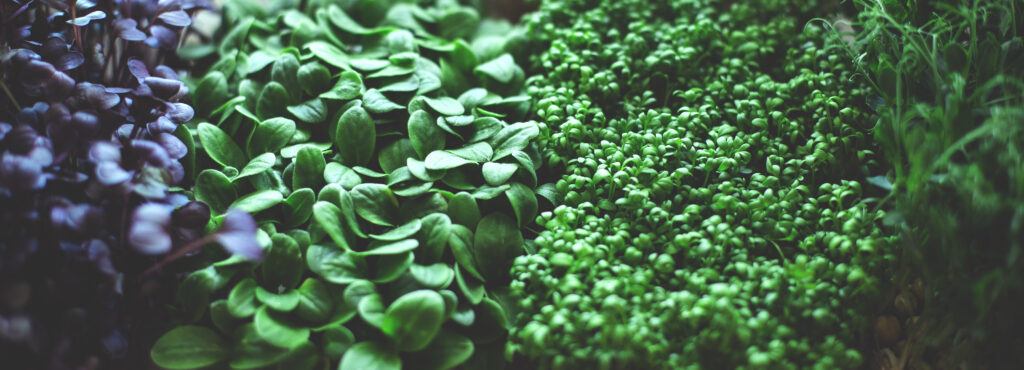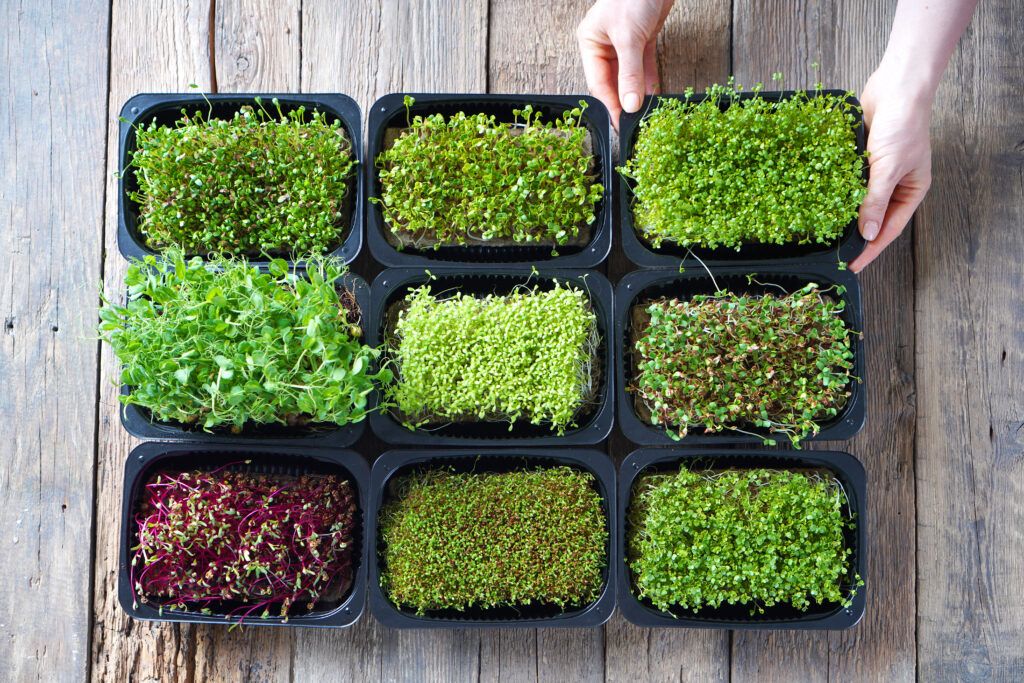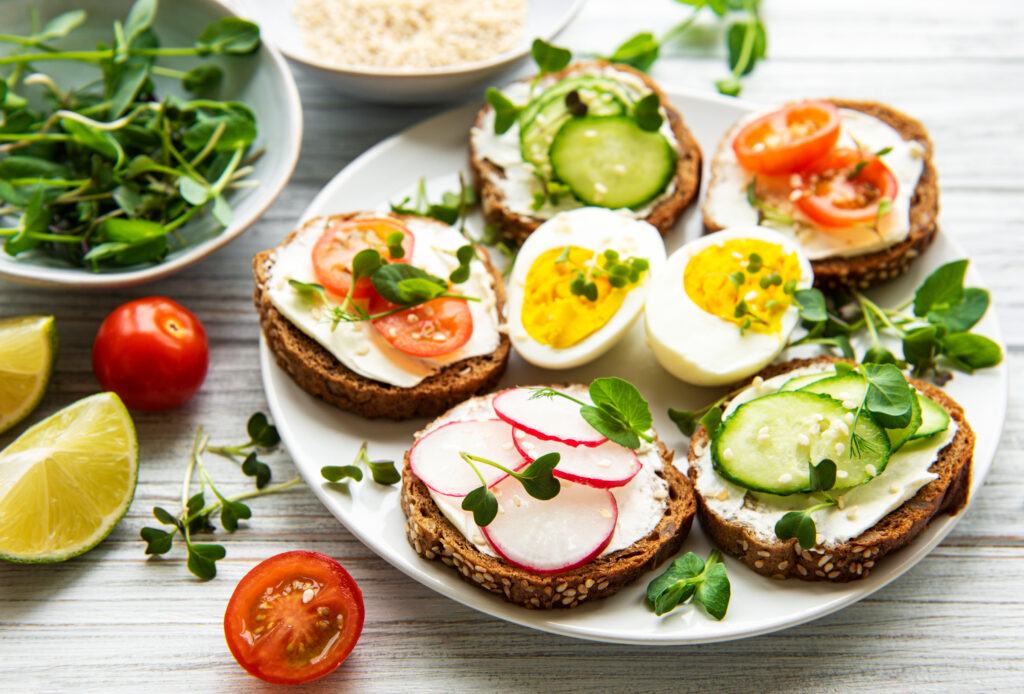If you are wondering whether sprouting grains and seeds is a fad, this article will dispel all your doubts. There are amazing benefits for eating sprouted seeds and grains and here is evidence.
Soaking grains and seed as well as sprouting them has many health benefits including increased nutritional content of this food group and increased bio-availability of minerals and vitamins. In this post I will share the science behind this bold claim.

Colourful sprouts and micro-greens
Packed With Available Nutrients
The following nutrients are present in bean sprouts: Folate and other B vitamins, iron, vitamin C, zinc, magnesium, calcium, potassium, phosphorous and proteins (USDA). There may also be less starch in sprouted grains, which makes them more easily absorbed compared to regular grains. It’s good for people who are sensitive to anti-nutrients that affect digestion of grains, according to experts at Harvard University. Less anti-nutrients means your body is not prevented from absorbing all the minerals and vitamins from these growing plants. The same nutrients, but in different quantities, are found in sprouted whole grains and regular whole grains.
They Taste Better Than When Mature; Especially Sprouted Seeds of Cruciferous Vegetables
Not everyone likes the taste of broccoli, cauliflower, cabbage or other cruciferous vegetables that have a bitter taste due to the sulphur containing beneficial plant chemicals. However, this unique flavour is not present in the sprouting vegetables and they are even sweet tasting (American Heart Association 2024).
They are Easy to Grow Indoors Meaning They May be Inexpensive

Luscious bean sprouts and micro greens
It is a simple and inexpensive process to produce sprouted seeds and greens, having little impact on the environment. They’re also capable of being grown at home, indoors or outside. So if you are a DIY enthusiast when it comes to your health foods, this is one you may enjoy.
How To Sprout Seeds/Grains At Home
To sprout your own seeds and grains at home, there are different approaches including soaking your seeds in a bowl of water with enough water to completely cover the seeds/grains and a depth of about two inches of water above the level of the seeds. Cover them up (preferably with plastic) and keep in a warm, well lit place. Alternatively use a glass jar as it is important for them to have light (non-direct sunlight or grow light).
There must be room for the seeds to swell as they absorb the water. Drain and lightly rinse them each day and repeat until they germinate and grow tiny leaves about 3-7 days depending on the type of seed. Another method includes the use of tissue or absorbent paper to line the bowl or other container and adding water before sprinkling the seeds on it. Cover and follow the other steps explained above, except for rinsing. As soon as green leaves appear start tasting them and avoid allowing time for them to become too mature.
Very Short Time to Grow and Harvest

The sprouted life of grains, legumes and greens begins as seeds that begin to grow when exposed to moisture and warmth. Many sprouted plants are ready to eat within a days, before their leaves grow. While tender, immature greens of arugula, radish, basil, and other plant seeds are usually harvested later than the sprouts and have a small stem and a very small pair of leaves that emerge in 10 to 20 days.
Sprouted Seeds and Micro-greens May Boost Immunity
When eaten raw these small green vegetables are a powerhouse of immune boosting nutrients like zinc and vitamin C. Vitamin C is good for improving the integrity and strength of most tissues in the body and are known to support the prevention and recovery from infections.
They Add Colour and Texture to Salads and Other Dishes
Young sprouts and greens add colour, texture and diverse flavours – from lentil and nut sprouts on salads, sandwiches and soups to micro-mint greens on appetisers, desserts and in smoothies. So versatile when you take time to appreciate their added benefits to your meals.
They Are Varied and Versatile: An Example is Bread Baking With Sprouted Grains
Bakers even add sprouted whole grains to bread, pasta and breakfast cereals, although certain methods of food processing may reduce their added nutritional value (AHA). You may add them to your home baked breads and scones, and even to soups and smoothies, after washing carefully.
Less Phytates (Anti-nutrient)
According to the American Heart Association (2022) Phytates, which bind to minerals such as zinc, iron and magnesium, are present in plant grains; this prevents absorption of these minerals into the body. There is no enzyme that humans have for the breakdown of phytates, but the germination process helps plant enzymes to be released in a way that enables them to easily absorb minerals. Likewise, lectins that make certain foods hard to digest are broken down and disarmed in the course of soaking or sprouting (Food Chem 1989).
Helps to Support Good Iron Levels (Prevents Anaemia)

Women in their child bearing years may find it beneficial to have sprouted seeds as they have more elemental iron available compared with mature green salad leave like spinach (uncooked) due to anti-nutrients such as phytates and lectins (Plant Food Human Nutrition 2019). But the germination or fermentation (when seeds are soaked but not for germination) process, breaks down these compounds that bind the nutrients and irritate the stomach.
Supports Strong Bones
Minerals such as magnesium and calcium play an important role in bone mineral density. So taking a good source of these minerals on a regular basis will help to prevent osteoporosis and fractures in women experiencing the menopause. Sprouted grains and seed are a great source of these bio-available minerals (American Department of Agriculture).
Safety And Caution With Sprouted Seeds And Grains
Raw or mildly cooked sprouts of any kind should not be eaten by children under the age of 5, adults over the age of 50, pregnant women and anyone with an impaired immune system. Due to the drawbacks that eating raw sprouts risks ingestion of bacteria, including salmonella, listeria and E. coli, thrive in a warm, moist environment where they are grown. Before sprouting, ensure good quality seed and sanitise with an undiluted vinegar or apple cider to reduce the risk of food borne disease (Food Safety Authority Ireland).
In Summary: List of 10 Benefits of Sprouted Grains
- Packed with available nutrients
- They taste better than when mature; especially sprouted seeds of cruciferous vegetables
- They are easy to grow indoors meaning they may be inexpensive
- Very short time to grow and harvest
- Sprouted seeds and micro-greens may boost immunity
- They add colour and texture to salads and other dishes
- They are varied and versatile: an example is in bread making
- Less phytates (anti-nutrient)
- Helps to support good iron levels and fights anaemia
- Supports strong bones

Interesting… Thanks for sharing.
Hi Dinesh, thanks for reading and commenting.
Best wishes,
Brenda
Hi Brenda,
Website is informative and set out well.
I will have to try these for my own health.
Are you going to add an extra picture to the page?
Keep up the good work, very professional Brenda.
Hi Russell, Thanks you very much for reading and kind words of encouragement and positive feedback. I do plan to edit the post and add more images.
Best wishes,
Brenda
Hi Russell,
just a quick message to say that I have added more pictures as you suggested and also more content about how to sprout your own grains at home. Thanks again for your suggestion on placing more images in the article.
Best wishes,
Brenda
Sprouted grains sound wonderful. I like that you have explained their benefits. I wonder if you could explain what they are. This might be another post, perhaps with a more in-depth look at how to cultivate them.
Hi Simon,
many thanks for your helpful suggestion. I have now added a new section on how to sprout your own seeds at home. And some nice pictures too. Please let me know if there are other topics about health you would like to see.
Best wishes,
Brenda
Hi Brenda. Thank you for sharing. It was really helpful to know more and I especially like the summary at the end for reference. My iron levels fluctuate so knowing that sprouted grains are another source I can add to my diet is great
Hi Tina, thanks for reading and the positive feedback on how relevant you found this article. Let me know if there are other health topics you would like to see on this website.
Best wishes,
Brenda
Hi again Tina,
just an update to say that I have updated the article with more pictures and a section on how to sprout your own seeds at home. Thanks again for reading and commenting.
Best wishes,
Brenda